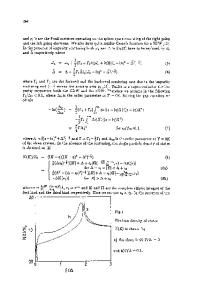Fermi Surface and Charge Density Waves in Second-Stage Graphite-Bromine Intercalation Compounds
- PDF / 311,020 Bytes
- 5 Pages / 420.48 x 639 pts Page_size
- 37 Downloads / 421 Views
F. BATALLAN, I. ROSENMAN and Ch. SIMON Groupe de Physique des Solides de l'Ecole Normale Supdrieure, Universit6 Paris 7, Tour 23, 2, Place Jussieu, 75251 Paris Cedex 05, FRANCE G. FURDIN Laboratoire de Chimie Mindrale Appliqude (A. Herold) Universitg Nancy 1, C0140, 54037 Nancy Cedex, FRANCE
ABSTRACT Results of de Haas van Alphen effect study on second-stage bromine graphite intercalation compound C 1 4 Br are presented together with a two dimensional model of electronic structure and Fermi surface. The results are characterized by a The nature of the mixing of deHaas-vanAlphen frequencies. coupling mechanisms between orbits is discussed. It is shown that the two dimensional Fermi surface of C14 Br contains nested parallel parts which can stabilize charge density waves. A comparison between the nesting vectors of this Fermi surface and the satellites and diffuse streaks found in structural studies shows a fair agreement between both.
INTRODUCTION Great progress has been made recently in understanding the unusual electronic properties of the graphite intercalation compounds. In particular the results of optical reflectivity and quantum oscillatory effects in the acceptor graphite intercalation compounds (GAC) have permitted construction of realistic models for the band structure. It is now currently admitted that the electronic properties of GAC are well described by a set of independent two dimensional (2-D) metallic units, whose band structure has been computed by several authors [1,2]. We started from one of such computations, made by Blinowski et al. [1] to interpret the optical reflectivity and explain the complex structure of magnetothermal oscillations in the second-stage $-HN03 GAC[3]. The Blinowski et al. model takes into account only the periodicity of the carbon atoms whereas the quantum oscillatory effects are also sensitive to the intercalate in-plane order. We had introduced the latter by folding the graphite Brillouin zone (BZ) into that of the GAC. This resulted in orbits which could be coupled by magnetic breakdown (MB). In recent results of the de Haas-van Alphen (dHvA) effect in second-stage bromine GAC we have also observed many combinations of orbits. We shall present here these results as an illustration of the coupling mechanisms in the dHvA frequencies in the GAC. We find that the Fermi surface (FS)shape, got from our dHvA experiments, supports charge density waves (CDW) by nesting of its parallel parts. The possibility of CDW is also confirmed by structural studies of bromine GAC. THE DE HAAS-VAN ALPHEN EFFECT The dHvA effect is a powerful technique to get information about electrons at the Fermi level. As is known, from the ddvA effect we obtain the extremal cross
Hat. Res.
Soc. Symp. Proc. Vol.
20 (1983)
sElsevier Science Publishing Co.,
Inc.
130
S100!
Aa
M-~
0
1000
2000
3000
4000
B (TESLAS) Fig. 1. Typical spectrum of de Haas-van Alphen effect on the second-stage bromine intercalation compound.
TABLE I dHvA frequencies F (in Tesla) and the corresponding effective masses
Data Loading...











